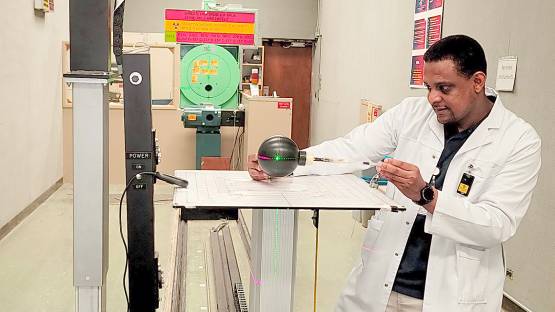Kilometres, minutes, grammes, litres, miles, inches, parts per million… We use them every day to communicate what we do, how far we go, how much we eat… But what about millisieverts and grays that save lives?
Accurate dosimetry is key to ensuring quality in medical radiation therapy, diagnostic radiology and for radiation protection of staff working in these fields: it is accurate dosimetry that helps professionals ensure that the optimal radiation dose gets administered to patients. On this World Metrology Day, the IAEA joins global partners in commemorating this year’s theme: Measurement for Health.
In 1976, the IAEA and the World Health Organization (WHO) established a Network of Secondary Standards Dosimetry Laboratories (SSDLs). Together with the IAEA’s own dosimetry laboratory in Seibersdorf, these laboratories play a major role in providing calibrations that assist countries in performing accurate dosimetry in their radiotherapy and diagnostic radiology departments. Calibration gives assurance that the measurements being performed on the equipment are reliable.
With the aim of transferring skills, particularly to developing countries, through the SSDL Network, the IAEA trains staff from around the world in performing calibrations for various fields. Since 1987, more than 300 scientists from 122 countries have been trained in various aspects of dosimetry. This has enabled several countries to provide accurate dosimetry services, and therefore safe and effective radiation therapy and diagnosis.
Kenya is one country that benefitted from this fellowship training scheme when radiation metrology officers from the Kenya Bureau of Standards (KEBS), Grace Ateka and Collins Omondi, received training in radiation therapy, diagnostic radiology and radiation protection calibration as well as in developing a quality management system (QMS) at the National Metrology Institute of South Africa (NMISA) in 2019. The training was arranged and financed by the IAEA’s technical cooperation programme.
“Knowledge gained during the fellowship will assist us in ensuring that KEBS performs dosimetry calibrations covering all the areas needed,” said Ateka. “The Kenyan Government is currently upgrading more than 50 county hospitals with state-of-the-art facilities that include many radiology units.”
Omondi added: “Our laboratory is in the process of establishing a calibration service for radiotherapy. And we are also preparing to undergo formal accreditation for the current services. This was made possible through the assistance of the IAEA and by being part of the SSDL Network.”
Knowledge gained during the fellowship will assist us in ensuring that KEBS performs dosimetry calibrations covering all the areas needed.







